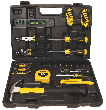Painting Bathroom Cabinets
Written by Lee Wyatt (last updated April 4, 2022)
Whether you are living in a house or an apartment more than likely you are going to want to do some redecorating in your bathroom. Quite often, though, in today's troubled economy the funds for a complete remodel are simply out of the question. That being said, there is a simple solution that many people often overlook: Painting your bathroom cabinets.
This is a simple home improvement project that anyone can do over the weekend. All that you need in order to accomplish this task is a little time, effort (meaning some elbow grease), and a few other items. These other items can be obtained at any home improvement store (such as Home Depot, Lowes, or others).
Materials and Tools:
- Paint.
- Sandpaper (150 to 220 grit)
- Paint brushes
- Wood primer
- Large plastic tarp
- Paint pan
- Paint roller
Steps:
- Remove. The first step in being able to repaint your bathroom cabinets is to remove the old ones. While it is not necessary to completely remove the old cabinets, but you should at the very least remove the cabinetry doors and drawers. Take these items to a dust free, and well-ventilated area that you have prepared to work in. Prepare your work area by laying out the tarp so that you do not stain anything with the paint from your work. At this time, you should also remove all the hardware and pulls, so that you can more easily paint everything.
- Clean. After you have everything completely removed, you now need to go ahead and give everything a thorough scrubbing. Some might say that this is not a really necessary step, but let me assure you that it is a vital step. In the event that you don't clean everything, don't be surprised if you find yourself needing to repaint everything in a few months.
- Sand/Strip. Once everything has dried completely, it is time to go ahead and remove all the old paint, stain or finish. Simply identify which is on your cabinets, and then proceed to remove all of the old stuff. This could entail using chemicals, or simply sanding everything.
- Prime. Once you have removed all the old finish, go ahead and start priming. Do this just as if you were painting something. Between each coat (and you are going to want at least two coats), allow a minimum of fifteen minutes for drying. After the wood primer has dried, take some of the fine grit sand paper (220 wet/dry or finer) and use only enough pressure to hold the paper to the wood, and rub it back and forth to even out the primer. Do this after each of your coats.
- Paint. Only begin painting after the primer has dried out. Use either a paintbrush or the paint roller to apply the paint. Once again, you need to allow a minimum of 15 minutes for drying between each coat. You also need to repeat the sanding process as described in the above step. Allowing some time between each coat is also going to help you get the desired color, since paint typically darkens as it dries.
- Reassemble/Clean. After you have achieved the color you are looking for, go ahead and begin to reassemble everything. This is the time when you want to go ahead and install any new hardware/pulls that you may have purchased. When you have put everything back together, you are ready to clean everything up.
Author Bio
Lee Wyatt
Contributor of numerous Tips.Net articles, Lee Wyatt is quickly becoming a regular "Jack of all trades." He is currently an independent contractor specializing in writing and editing. Contact him today for all of your writing and editing needs! Click here to contact. Learn more about Lee...
Roof Contractors
Whether it is from a sudden storm, or your home has experienced a growth spurt there will come a time when you need to ...
Discover More
Keeping Driveways Maintained
A driveway is more than something to make your home look pretty. Since your driveway is also an investment, this means ...
Discover More
Repairing a Leaking Tank
Over time just about everything will leak, and your toilet is no different. Perhaps one of the more annoying locations ...
Discover More
More Home Improvement Tips
Choosing Quality Paint
Perhaps one of the most commonly overlooked aspects of any painting project is when you actually choose the paint. The ...
Discover More
Removing Paint from Brick
Do you have a home that has a brick wall that has been painted over? Would you like to change that color of paint, or ...
Discover More
How Do You Rag Paint a Wall?
If you are looking for a fantastic way to paint your wall, and create a truly unique look then you simply have to look ...
Discover More

Comments